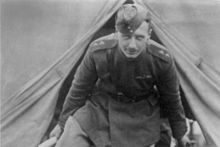William Leefe Robinson
| Leefe Robinson | |
|---|---|
 |
|
| Birth name | William Leefe Robinson |
| Born | 14 July 1895 Pollibetta, Coorg, India |
| Died | 31 December 1918 (aged 23) Stanmore, England |
| Buried at | All Saints' Churchyard Extension, Harrow Weald, Middlesex |
| Allegiance |
|
| Years of service | 1914–1918 |
| Rank | Captain |
| Unit |
39 Squadron 48 Squadron |
| Commands held | Flight Commander |
| Battles/wars | World War I |
| Awards | Victoria Cross |
William Leefe Robinson VC (14 July 1895 – 31 December 1918) was the first British pilot to shoot down a German airship over Britain during the First World War.
For this he was awarded the Victoria Cross, the highest award for gallantry in the face of the enemy that can be awarded to British and Commonwealth forces. He was the first person to be awarded the VC for action in the UK.
His action marked a turning point in the war against the airship menace, and caused the German airship bombing campaign to falter. In the three months afterwards five more airships were shot down, using the combat techniques he had proven.
Robinson was born in Coorg, India, on 14 July 1895, the youngest son of Horace Robinson and Elizabeth Leefe. Raised on his parents' coffee estate, Kaima Betta Estate, at Pollibetta, in Coorg, he attended Bishop Cotton Boys' School, Bangalore, and the Dragon School, Oxford, before following his elder brother Harold to St. Bees School, Cumberland in September, 1909. While there he succeeded his brother as Head of Eaglesfield House in 1913, played in the Rugby 1st XV and became a sergeant in the school Officer Training Corps.
In August, 1914 he entered the Royal Military College, Sandhurst, and was gazetted into the Worcestershire Regiment in December. In March, 1915 he went to France as an observer with the Royal Flying Corps, to which he had transferred. After having been wounded over Lille he underwent pilot training in Britain, before being attached to No. 39 (Home Defence) Squadron, a night-flying squadron at Sutton's Farm airfield near Hornchurch in Essex.
...
Wikipedia
